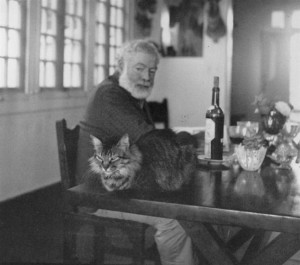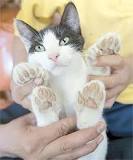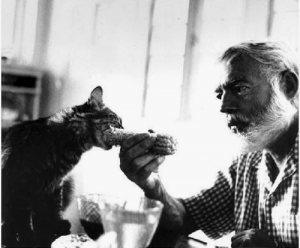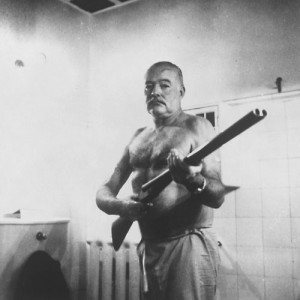In Cuba, the famous american writer Ernest Hemingway had fifty-seven cats and five dogs roaming the grounds of his hilltop home “La Vigia” (Lookout Farm).
The Finca at the time consisted of 15 acres (61,000 m2) with a farmhouse. It was at Finca Vigía that he wrote much of For Whom the Bell Tolls (a novel of the Spanish Civil War which Hemingway had covered as a journalist with Gellhorn in the late 1930s—the novel was started at the Ambos Mundos, and some was also written in Idaho). Hemingway would later buy the property out of some of the first royalties from the book, published in 1940.
It was at the Finca that Hemingway began to keep and breed cats (he had kept only peacocks in Key West). Hemingway started with a gray Angora cat obtained in Key West from a breeder, named Princessa and later in 1942 picked up two male Cuban kittens named Good Will and Boise. Hemingway was to write extensively about the habits of Boise. By 1943, the cat population at the Finca numbered 11. When Mary Hemingway moved into the Finca in 1946, she had a writer’s workshop tower constructed on the property, but Hemingway preferred to work in his bedroom, and the workshop was eventually assigned to the cats.
One of the first cats Hemingway purchased in Cuba was a Persian female named Tester that came from the Silver Dawn Cattery in Florida. Tester was renamed Princessa by the Finca staff because of her elegant nature. Later Princessa mated with Boise – whom Papa first called Dillinger – a Cuban kitten he had found in the coastal fishing village of Cojimar. By the end of the first summer, he owned three house cats: Princessa, Boise, and a half-Maltese kitten named Willy.
Ernest took great pleasure in writing to his family about his cats and how they were getting along. By 1943, Ernest and third wife Martha had eleven cats at Finca Vigia. “One cat just leads to another . . .” he wrote to his first wife, Hadley Mowrer. “The place is so damned big it doesn’t really seem as though there were many cats until you see them all moving like a mass migration at feeding time. . . . It is wonderful when Marty, and /or kids are here but is lonesome as a bastard when I’m here alone. I have taught Uncle Wolfer, Dillinger and Will to walk along the railings to the top of the porch pillars and make a pyramid like lions and have taught Friendless to drink with me (whiskey and milk) but even that doesn’t take the place of a wife and family.” Some of the cats had nicknames for his wives that were cat’s names and often signed his letter, Big Kitten.
Ernest later uses his isolation from his family and his kinship with his cats as inspiration for his hero, Thomas Hudson, in his novel, Islands in the Stream. Hudson talks to his cats and was comforted by them after learning of his sons’ tragic deaths in a car accident. Princessa is elegant and aristocratic, while Boise is the male cat who hunts fruit rats and is devoted to Thomas Hudson. Goats [aka Bigotes, Friendless] is the fighter and stud cat. All three cats are immortalized in this novel.
By the time Papa’s fourth wife to be, Mary Welsh, moved into the Finca in 1945, Ernest had twenty-three cats and five dogs. They were treated as royalty. The cats slept in the guest bedroom and later lived in a room on the second floor of the white tower Papa had built for his pets at one end of the terrace. He and Mary called the cats “purr factories” and “love sponges” that soaked up their love and in return gave them comfort and companionship.
Among the many family letters describing his cats is one written in 1942. Ernest tells Hadley Mowrer that he had not been able to sleep the night before and had recalled a song they had composed for their cat, F. Puss, so many years earlier in Paris. It went like this, “A feather kitty’s talent lies In scratching out the other’s eyes. A feather kitty never dies Oh immortality.” According to the letter, the Finca cats enjoyed Papa’s song.
He once wrote in a letter from there: “One cat just leads to another. . . . The place is so damned big it doesn’t really seem as though there were many cats until you see them all moving like a mass migration at feeding time.” He called the cats “purr factories” and “love sponges” that soaked up love and in return gave them comfort and companionship.
It was in 1960 when Hemingway responding to a columnist who criticizes him for living in Cuba said, “You find me a place in Ohio where I can live on top of a hill and be fifteen minutes away from the Gulf Stream and have my own fruits and vegetables the year around… and I’ll go live in Ohio if Miss Mary and my cats and dogs agree.”
In the early morning hours of July 2, 1961, Hemingway “quite deliberately” shot himself with his favorite shotgun.He unlocked the basement storeroom where his guns were kept, went upstairs to the front entrance foyer of their Ketchum home, and “pushed two shells into the twelve-gauge Boss shotgun …put the end of the barrel into his mouth, pulled the trigger and blew out his brains.
I would like people to understand some of the reasons why the writer committed suicide, in the first place all his health problemas, but also remember his favorite cat ‘Big Boy Peterson’ usually slept with him every night and was probably the companion he needed most which left deep scars in his profound love for his beloved cats.
Wiki/Varioustexts/InternetPhotos/www.thecubanhistory.com
Ernest Hemingway in Cuba, his Cats and dogs.
The Cuban History, Hollywood
Arnoldo Varona, Editor
Foto por Liz Carrasco – Hotel Turistico “Memories”, Varadero, Cuba.

ERNEST HEMINGWAY EN CUBA, SUS GATOS Y PERROS
En Cuba, el famoso escritor norteamericano Ernest Hemingway tenía cincuenta y siete gatos y perros que vagan por las cinco razones de su casa colina “La Vigía” (Lookout Farm).
La finca en el momento consistía en 15 acres (61.000 m2) con una granja. Fue en la Finca Vigía, que escribió gran parte de Por quién doblan las campanas (una novela de la Guerra Civil Española que Hemingway había cubierto como periodista con Gellhorn a finales de los años 1930, la novela se inició en el Ambos Mundos, y algunos también escrito en Idaho). Hemingway más tarde iba a comprar la propiedad de algunos de los derechos de autor de la primera obra, publicada en 1940.
Fue en la finca que Hemingway comenzó a tener y criar gatos (había mantenido pavos reales sólo en Key West). Hemingway comenzó con un gato de angora gris obtenido en Key West, de un criador, llamado Princessa y más tarde, en 1942 obtuvo dos gatitos machos cubano llamado la Buena Voluntad y Boise. Hemingway era escribir mucho sobre los hábitos de Boise. En 1943, la población de gatos en la finca número 11. Cuando Mary Hemingway se mudó a la finca en 1946, tenía una torre escritor taller construido en la propiedad, pero Hemingway prefirió trabajar en su dormitorio, y el taller fue asignado eventualmente a los gatos.
Uno de los primeros gatos de Hemingway compró en Cuba fue un persa Tester hembra llamada que venía del criadero Silver Dawn de la Florida. Tester fue rebautizado Princessa por el personal de Finca a causa de su carácter elegante. Más tarde se aparearon con Princessa Boise – Papa quien primero llamó Dillinger – un gatito cubano que había encontrado en el pueblo costero de pescadores de Cojimar. A finales del primer verano, era dueño de tres gatos de la casa: Princessa, Boise, y un gatito medio maltés llamado Willy.
Ernest tuvo el gran placer de escribir a su familia acerca de sus gatos y cómo se llevaban bien. En 1943, Ernest y tercera esposa Martha tenía once gatos en Finca Vigía. “Un gato sólo lleva a la otra …” escribió a su primera esposa, Hadley Mowrer. “El lugar es tan condenadamente grande que realmente no parece como si hubiera muchos gatos hasta que usted los vea todo se mueve como una migración masiva a la hora de comer …. Es maravilloso cuando Marty, y / o los niños están aquí, pero es solo como un hijo de puta cuando estoy aquí solo. Me han enseñado el tío Wolfer, Dillinger y su voluntad de caminar a lo largo de la verja en la parte superior de los pilares del porche y hacer una pirámide como leones y han enseñado Sin amigos a beber conmigo (whisky y la leche ), pero incluso eso no toma el lugar de la mujer y la familia. ” Algunos de los gatos tenían apodos para sus esposas que eran los nombres de gato y, a menudo firmó su carta, Big Kitten.
Ernest luego usa su aislamiento de su familia y de su parentesco con sus gatos como inspiración para su héroe, Thomas Hudson, en su novela Islas en el Golfo. Hudson habla con sus gatos y fue consolado por ellos después de enterarse de la muerte de sus hijos en un trágico accidente de coche. Princessa es elegante y aristocrático, mientras que Boise es el gato que caza ratas fruta y se dedica a Thomas Hudson. Cabras [aka Bigotes, sin amigos] es el luchador y el gato semental. Los tres gatos están inmortalizados en esta novela.
En el momento en cuarta esposa de papá a ser, Mary Welsh, se mudó a la finca en 1945, Ernest tenía veintitrés gatos y cinco perros. Fueron tratados como la realeza. Los gatos dormían en la habitación de invitados y más tarde vivió en una habitación en el segundo piso de la torre blanca que papá había construido para sus mascotas en un extremo de la terraza. Él y María llamó a los gatos ronronean “fábricas” y “amor” esponjas que absorbían su amor ya cambio les dio consuelo y compañía.
Entre las cartas familiares que describen sus gatos es un escrito en el año 1942. Ernest dice Hadley Mowrer que no había podido dormir la noche anterior y había recordado una canción que había compuesto para su gato, F. Puss, tantos años antes en París. Decía así: “Un gatito pluma talento reside en tachar los ojos del otro. Un gatito pluma nunca muere Oh inmortalidad”. Según la carta, los gatos Finca disfrutado canción de papá.
Una vez escribió en una carta desde allí: “Un gato ssigue a otro… El lugar es tan condenadamente grande que realmente no parece como si hubiera muchos gatos hasta que vea a todos moviéndose como una migración masiva a la hora de comer. “El llamado de los gatos ronronean” fábricas “y” amor “esponjas que absorbían amor yo en cambio les doy consuelo y compañía.
Fue en 1960 cuando Hemingway responder a un columnista que lo critica por vivir en Cuba, dijo: “Me encuentre un lugar en Ohio donde pueda vivir en la cima de una colina, y estar quince minutos de la Corriente del Golfo y tengo mis propias frutas y verduras durante todo el año … y voy a ir a vivir en Ohio si la señorita Mary y mis gatos.. están de acuerdo. ”
En las horas tempranas de la mañana del 2 de julio de 1961, Hemingway “deliberadamente” se pegó un tiro con su shotgun. Ernest abrió la bodega del sótano donde se guardaban sus armas, subió las escaleras para el vestíbulo de entrada frente a su casa de Ketchum en Ohio, y “colocando dos balas en la escopeta calibre doce preferida de el,’Boss’… puso el extremo del cañón en su boca y apretó el gatillo volandose el cerebro.
Me gustaría que la gente entienda algunas de las razones por qué el escritor se suicidó, en primer lugar, todos sus males de salud pero ademas recuerdese que su gato ‘Big Boy Peterson’ usualmente se acostaba con él todas las noches y era probablemente el compañero que mas necesitaba y dejara profundas huellas en el amor desmesurado conque el escritor anhelaba de sus queridos gatos.
Wiki/Varioustexts/InternetPhotos/www.thecubanhistory.com
Ernest Hemingway in Cuba, his Cats and dogs.
The Cuban History, Hollywood
Arnoldo Varona, Editor



 ERNEST HEMINGWAY IN CUBA, HIS CATS AND DOGS (Photos) * * ERNEST HEMINGWAY EN CUBA, sus gatos y perros (Fotos).
ERNEST HEMINGWAY IN CUBA, HIS CATS AND DOGS (Photos) * * ERNEST HEMINGWAY EN CUBA, sus gatos y perros (Fotos).



